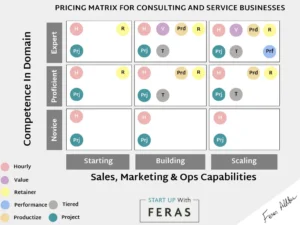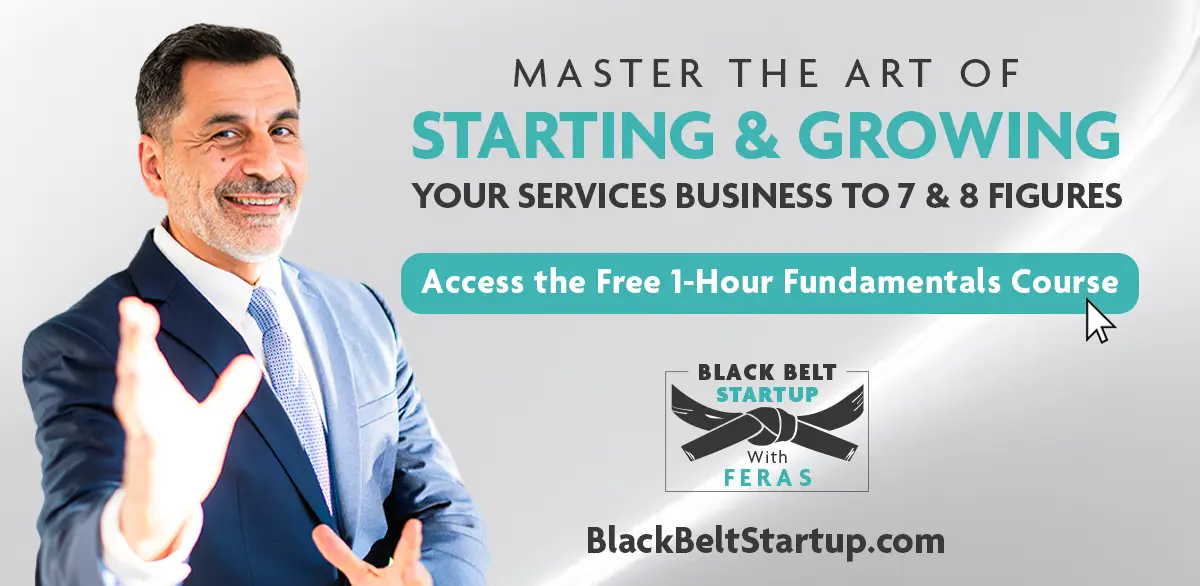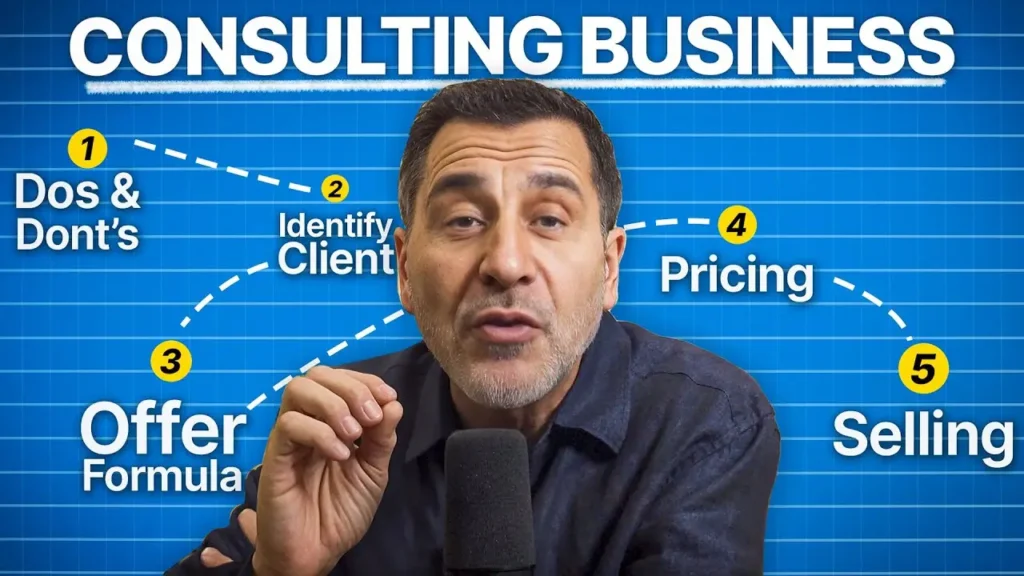Overcoming the Biggest Challenges Entrepreneurs Face When Starting a Business

Landing your first client or hitting your first big win in business is a major milestone, and it feels incredible. But whether you’re just getting started or beginning to grow, what comes next is often tougher than expected.
Most entrepreneurs believe the hardest part is starting. But in reality, the biggest entrepreneur challenges show up after you’ve taken that first step.
You begin running into strategic decisions you’re not prepared for, daily operational bottlenecks that slow everything down, and mindset blocks that quietly limit your growth.
In my own journey, I faced every one of these issues, sometimes all at once. And after working with dozens of service- and consulting-based business owners and consultants, I’ve learned that most challenges entrepreneurs face when starting a business boil down to three key areas: strategy, operations, and mindset.
Strategic Challenges Entrepreneurs Face & How to Overcome Them
If you’re feeling stuck, overwhelmed, or unsure how to scale further, you’re not alone.
Here is exactly how to recognize, tackle, and overcome the hidden challenges entrepreneurs face when starting a business so your consulting or service startup can finally reach its full potential.
Challenge #1: Getting Stuck Handling Tasks Outside Your Expertise
In the early days, entrepreneurs naturally wear many hats to keep costs low, but if they don’t start delegating some responsibilities as soon as reasonably possible, they shoot themselves in the foot. I fell into the same trap. As my firm grew, I wasted countless hours buried in bookkeeping and accounting work I wasn’t even skilled at.
Although I initially thought my frugality was resourceful and wise, the reality was costly: it pulled my attention away from critical activities like refining our offerings, deepening client relationships, and building strategic partnerships.
Here’s the hidden danger: opportunity cost. Every hour spent wrestling with tasks you aren’t trained for is an hour you could have invested in activities that truly drive growth and profit. This mistake quietly stunts your progress.
Strategic actions to overcome this challenge:
- Calculate your real hourly worth: Take your revenue goal and divide it by your productive hours. If your hourly value is $250/hour, why spend hours on tasks you could pay someone else $25/hour to do? Let go of tasks beneath your pay grade.
- Delegate with discipline: Hire or contract specialists for tasks outside your skill set, including accounting and marketing. For general administrative support, hire a virtual assistant.
- Double down on strengths: Shift your freed-up time and energy to high-value activities that drive growth, such as enhancing your service offerings, cultivating strategic relationships and partnerships, and sales strategies.
Challenge #2: Differentiating Your Business Clearly in a Crowded Market
Standing out in a saturated market is tough. But here’s the uncomfortable truth: blending in is worse. It silently robs you of opportunities and makes you compete primarily on price.
For example, consider accounting professionals; there are over 1.4 million accountants in the U.S., with more than 115,000 just in California. Without clear differentiation, even highly skilled professionals risk being viewed as commodities.

California accountancy licensees by type (source: California Board of Accountancy)
The secret to breaking this cycle? Niching down reasonably, but not so far that you limit discovery before seeing who actually responds to your messaging and offers.
Strategies to differentiate your business clearly:
- Perform a competitor gap analysis: Instead of guessing what clients might want, analyze your competitors. What’s missing? What underserved niche can you uniquely fill?
- Clarify and amplify your USP: Identify precisely why a client should pick you over others. Is it your process, specific results, niche expertise, or customer experience? Clearly communicate this repeatedly.
- Create visible thought leadership: Develop content (blogs, podcasts, webinars) that highlights your unique perspective and expertise. When prospects see you consistently addressing their exact needs, they naturally gravitate toward you.
- Double down on testimonials & case studies: Highlight highly specific results for your targeted niche. Nothing differentiates more powerfully than tangible evidence from delighted clients within your specialized domain.
Challenge #3: The Danger of Underpricing Services
In the early days, many of us focus on “just selling” our services to get our first clients and build momentum. I did the same. I set my prices low so I could secure deals quickly.
That approach helped me get in, and I still say it’s useful. But if you stay there too long, it’s like quicksand; it slowly pulls you down.
Why low prices can be dangerous:
- It devalues your work: Charging too little sends a message that your expertise isn’t worth much. This can hurt your reputation and make clients expect rock-bottom rates forever.
- You end up overworked: When you underprice, you may need to take on too many projects to make a decent income, leaving you with little time to focus on growing your business.
- Stunted growth: What worked for reaching 100K in revenue won’t get you to 250K, 500K, or 7 figures. As your business grows, you must change your pricing strategy to match your improved systems and processes.
Finding the right balance:
- Just sell in the early stages: When you’re just starting out, it’s okay to use lower pricing to gain traction. Focus on learning from every sale and building your client base.
- Offer tiered packages: Provide different service levels—basic, premium, and VIP. This approach lets you cater to clients on a budget while also offering a premium option for those who can benefit from enhanced and expanded services.
- Transition to value-based pricing: As soon as you have a steady flow of clients and revenue, shift your mindset. Instead of charging by the hour, charge based on the transformation you deliver. For example, if your consulting helps a client double their leads, your fee should reflect that impact.
- Keep evolving: Regularly review your pricing as your skills and services improve. Adjust your rates so they match the quality and results you provide.

Pricing matrix for consulting and service business
The Pricing Matrix above helps you clearly visualize how your pricing strategy can evolve as your business grows (Starting → Building → Scaling) and your competence deepens (Novice → Proficient → Expert).
- Horizontal Axis (Business Capabilities): Represents the maturity of your Sales, Marketing & Operations capabilities, divided into three stages: Starting, Building, and Scaling.
- Vertical Axis (Competence in Domain): Reflects your level of expertise and skill within your industry or specialty: from Novice, through Proficient, to Expert.
- Pricing Models (Circles): The colored circles show the best-fit pricing methods for each intersection such as Hourly (H), Value (V), Retainer (R), Project (Prj), Tiered (T), Performance (Prf), and Productized (Prd).
Suppose you’re a proficient consultant in digital marketing (Proficient) and your business is currently in the building stage. According to the matrix, you might benefit from using a combination of pricing methods such as:
- Hourly rates (H) for initial consultations
- Project-based fees (Prj) for clearly defined deliverables
- Productized services (Prd) to standardize and streamline your offerings
- Tiered pricing (T) to provide flexibility to clients based on their budgets
- Retainers (R) to secure predictable monthly revenue
As your expertise and business maturity increase (Expert, Scaling), you might shift toward high-leverage models like:
- Value-based pricing (V) that reflects client outcomes
- Performance-based pricing (Prf), where your compensation is directly tied to measurable results
- Higher-value Retainers (R) to ensure ongoing growth and stability
This strategic evolution in your pricing not only helps optimize your earnings, it also positions you clearly as an expert who understands their true value.
With your strategic pricing clarified, the next essential step is to confront the mindset challenges you must overcome as an entrepreneur.
Mindset Challenges Entrepreneurs Must Overcome
Entrepreneurship Is 5x Harder Than You Expect
Many new entrepreneurs believe passion alone will carry them through. The truth is, running a business is at least five times harder than you imagine or, as NVIDIA founder Jensen Huang famously put it, “Starting a company is a million times harder than you think. Whatever it is you imagine, it’s way harder.”
It’s not just about having a great idea. Entrepreneurship means long hours, tough setbacks, and financial ups and downs.
I learned early on that passion alone isn’t enough. You must be willing to work hard, acquire new skills, and continuously learn all aspects of running a business, not just delivering the service you’re already good at.
I once watched a consulting firm struggle because they thought their early wins meant they could relax.
They soon discovered that what worked to reach 100K in revenue would not carry them to 7-figures. Success demands more effort and learning every single day.
As Peter Drucker famously said, “If you want something new, you have to stop doing something old.” For entrepreneurs, that means letting go of outdated habits and fully committing to growth. And one of the most limiting habits of all? Resisting change.
Fear of Change & Resistance to Adaptation
While some entrepreneurs hold themselves back by thinking too small, others stall because they resist change. Fear of change can lock you into old habits, even when your market demands something new.
For example, a consultant I knew stuck rigidly to traditional marketing methods, believing digital trends were just temporary. As clients increasingly requested digital strategies, he ignored their needs, insisting his way was proven and reliable. Eventually, those clients left for competitors who weren’t afraid to adapt. By the time he finally embraced digital marketing, he’d already lost significant business.
The lesson? Successful entrepreneurs don’t say, “This has always worked.” They ask, “What could work better?” Being adaptable isn’t a bonus; it’s a requirement for long-term success.
But resistance to change isn’t the only mindset trap. Playing it too safe, thinking small when it’s time to go big can quietly hold your business back just as much.
Thinking Too Small & Playing It Safe
Another common trap is playing it safe. Many entrepreneurs limit themselves by staying in a small, comfortable space.
If you choose to be a solopreneur with only small goals, you keep yourself boxed in. I met a consultant who always took on small projects because they felt secure. He got stuck around selling $5K projects and never made it to 7 figures. At the same time, another firm took a brave step by taking on larger projects for larger companies with a high chance of recurring revenue from these large clients.
That firm quickly became known as the expert in their area and grew quickly. Their willingness to set big, bold goals made all the difference.
The lesson here is clear: to truly grow, you must dare to dream big and take smart risks. Decide whether you want to stay small or build a business that expands and thrives.
But mindset alone isn’t enough, even with big goals and bold vision, the way you run your business day to day can quietly sabotage your progress. That’s where tactical execution comes in.
Tactical Startup Challenges That Cause Growth Problems
When your systems and processes are stuck in the past, growth suffers. Even if your business is doing well on the surface, outdated habits, especially around how you communicate, hire, and operate, can quietly hold you back.
Lack of Responsiveness & Poor Customer Communication
In business, even a small delay can cost you a client. I once watched a great deal slip away simply because we didn’t reply fast enough. That moment taught me something crucial: quick, clear communication isn’t optional, it’s a competitive edge.
One method that really works is the 2-1-2 approach:
- Respond to new messages within 2 hours
- Follow up within 1 day
- Reconnect within 2 days if there’s still no response
Alternate with the 4-2-4 approach
If the 2-1-2 rule doesn’t match your workflow, maybe a 4-2-4 standard (4 hours, 2 days, 4 days) fits better—that’s perfectly fine. The point is not the exact timing; it’s about establishing a clear response standard your clients can rely on and that you consistently stick to.
Difficulty Hiring & Retaining the Right Talent
Another common problem startups face is hiring too quickly without a thoughtful approach. In the rush to scale, many entrepreneurs fill roles rapidly, overlooking cultural fit and long-term potential.
As a result, I’ve seen many highly talented employees leave prematurely, not because they lacked skill or motivation, but because the company failed to build a cohesive team environment or clearly define roles and expectations.
I once worked with a consulting firm that slowed down its hiring process. They looked for people who not only had the right skills but also shared the company’s values. This careful approach built a team that stayed together and pushed the business forward.
Underutilizing Technology and Automation
Far too many entrepreneurs build their businesses on outdated systems without realizing the cost. Manual tasks like chasing invoices, tracking projects in email threads, or forgetting to follow up with leads create a silent drag on your growth.
The right tools don’t just make things easier, they create the breathing room to focus on higher-value work.
Recently, innovative AI-powered recruiting platforms like HireEZ or Fetcher.ai can even help you identify ideal candidates faster, predict their fit, and automate initial outreach.
For scheduling meetings seamlessly, use tools like Calendly or Doodle, or newer AI-driven scheduling assistants like Motion or x.ai.
To track your team’s performance and engagement, consider platforms such as BambooHR, 15Five, or AI-powered tools like Lattice or Leapsome, which help analyze employee feedback and spot potential problems early.
Even with these powerful tools, remember that no software can replace a clear and strong company culture from day one. When your team feels part of a shared mission, they stick around and help you grow.
Key Takeaways and Actions
Your journey to growing a thriving consulting or service business is filled with hurdles both in your daily operations and in your mindset. To move beyond chasing small wins and reach long-term success, consider these actions:
- Delegate Early & Invest in Automation: Stop wasting precious time on tasks outside your expertise. Use tools like automated invoicing, CRMs, and scheduling apps to free up your time so you can focus on the work that truly matters.
- Carve Out Your Niche: Don’t be a jack-of-all-trades. Define what makes your service unique and focus on serving that specific market. When you stand out, clients know exactly why they should choose you over everyone else.
- Set Smart, Strategic Prices: Early on, it might help to “just sell” at lower rates, but if you want to grow, you need to move to pricing that reflects your value. Charge based on the results you deliver, and avoid getting stuck in low-profit deals.
- Embrace the Hard Truths of Entrepreneurship: Remember, running a business is five times harder than it looks. Be ready for long hours, setbacks, and learning curves. Passion alone isn’t enough—you must be prepared to work, learn, and adapt every day.
- Think Big & Take Calculated Risks: Playing it safe might feel comfortable, but real growth comes when you set bold goals. Challenge your limiting beliefs and take smart risks that can open up new markets and opportunities.
- Be Open to Change: Fear of change and clinging to old ways can hold you back. Learn to delegate, welcome new ideas, and ask yourself, “How can we improve?” Adaptability is key to overcoming obstacles and staying ahead of the competition.
By putting these ideas into practice, you can break free from the traps that slow down your business. Focus on modernizing your systems, carving out a unique niche, setting strategic prices, and, most importantly, growing your mindset. These steps will transform common startup challenges into stepping stones for lasting success.




